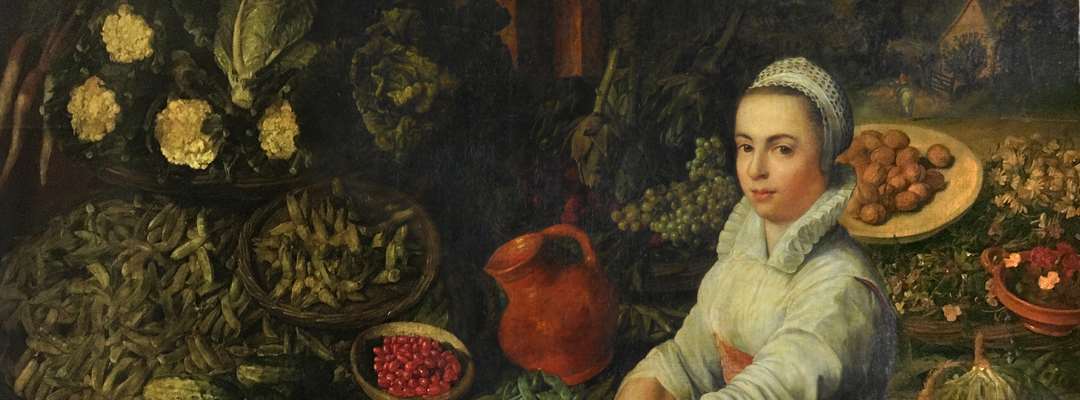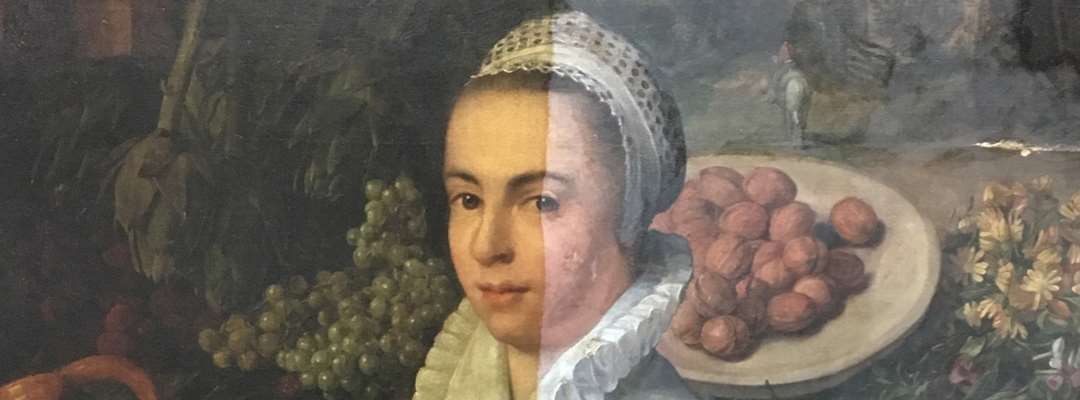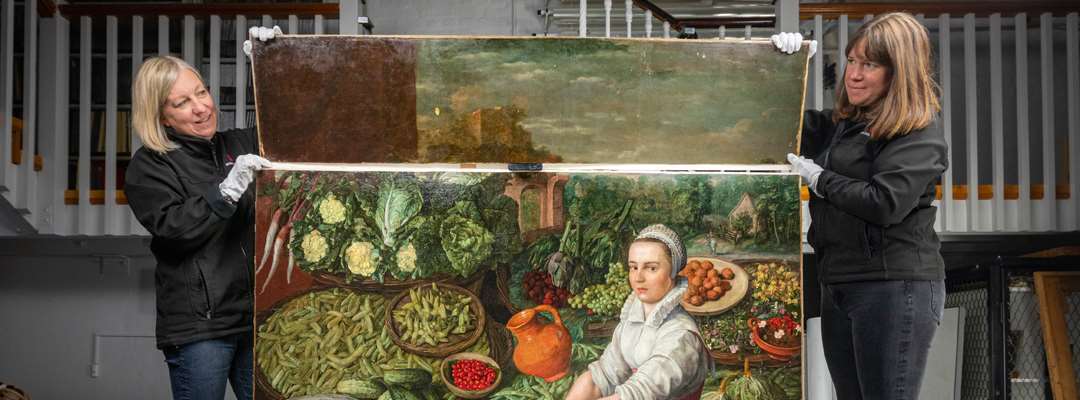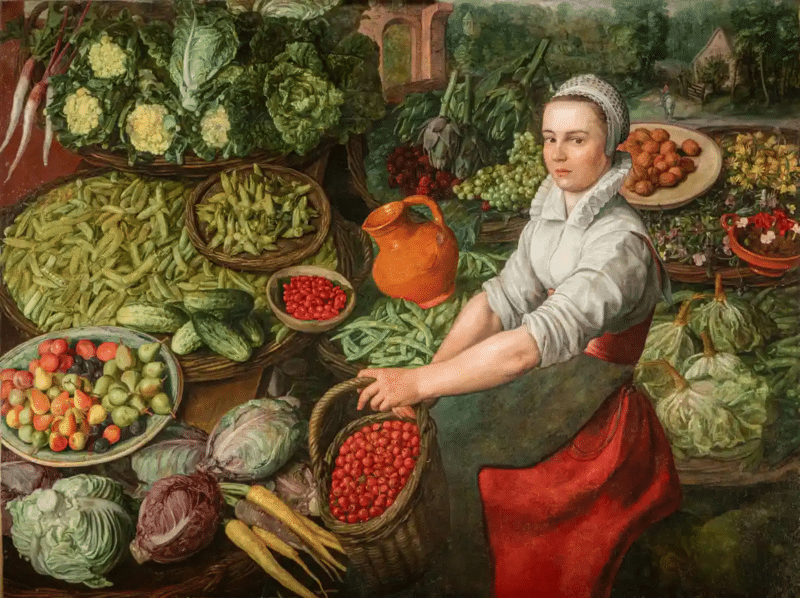450-Year-Old Flemish Painting ‘Vegetable Seller’ Restored
Visitors to Audley End House in Essex are able to see an important sixteenth-century Flemish painting, known as The Vegetable Seller, reinstated to the historic house’s art collection for the first time in 60 years. It is also the first time in centuries that the painting can be seen as it was originally conceived, having been restored to its former glory by conservators at English Heritage over the past two years.
Experts at the charity now believe they have uncovered strong evidence to link the work to the Antwerp born painter, Joachim Beuckelaer (ca. 1535–1575). It may even have been painted by the artist himself. Beuckelaer was known for his influence on the development of still life art in Northern Europe and Italy, whose most famous works include The Four Elements, in the collection of the National Gallery, London.
 The painting before treatment
The painting before treatment© English Heritage / Photo: Christopher Ison
The painting had previously been something of a mystery to curators at Audley End, with the full history of the canvas lost over time. Depicting a lone female figure looking out at the viewer surrounded by an array of produce, The Vegetable Seller was acquired for Audley End during the second half of the eighteenth century by Sir John Griffin Griffin, who owned the house at the time. Unsigned and in poor condition, it was impossible to date the work conclusively.
Restoration of the painting began at the English Heritage conservation studio in 2019, with conservators hopeful to not only reveal the original colours underneath darkened varnish and deterioration, but to also reveal the artist’s identity.
 The painting during restoration
The painting during restoration© English Heritage / Photo: Christopher Ison
Following the two-year restoration project, expert curators at English Heritage now believe the painting has close associations to 16th-century Antwerp painter, Joachim Beuckelaer (c.1535–75), or even have been painted by the artist himself.
Following the removal of the degraded varnish and areas of overpainting, remarkable likenesses have been established between The Vegetable Seller and other works by Beuckelaer, with non-invasive infrared imaging pointing to further similarities in technique. These findings have also helped date the painting to the late 16th century when Beuckelaer was working, and just before the Dutch Golden Age, overturning previous assumptions that the painting could be an 18th-century copy.
 Sometime in the late 18th or early 19th century, a strip of canvas had been added to enlarge the original rectangular format of the painting into a square.
Sometime in the late 18th or early 19th century, a strip of canvas had been added to enlarge the original rectangular format of the painting into a square.© English Heritage / Photo: Christopher Ison
As well as coming closer to uncovering the artist, expert restorers discovered that at some point in the painting’s history the format of the work had been drastically altered. No longer hidden by the darkened varnish it became clear that sometime in the late 18th or early 19th century, a strip of canvas had been added to enlarge the original rectangular format of the painting into a square. This discovery posed a real dilemma: the alteration was part of the painting’s history, however once cleaned the mismatch of the addition compared to the original painting was glaringly obvious.
Consulting with the painting’s current owner – a descendent of Sir John Griffin Griffin, who first brought it to Audley End in the 18th century – the decision was made to carefully remove the addition, which is now stored safely with the painting.
 'The Vegetable Seller' after restoration
'The Vegetable Seller' after restoration© English Heritage / Photo: Christopher Ison
As well as the removal of the top addition to the painting, extensive over-paint, added in past restoration attempts, was carefully removed by conservators to expose the artist’s original intentions underneath. As more of this was revealed the differences to the existing painting were quite remarkable illuminating much of its subject matter in finer detail than before. This included the subtleties in the figure’s expression – a previously upturned smile (added by a previous restorer) disappeared to reveal a more enigmatic expression. The restoration also revealed the rich array of colours in the abundance of fresh produce on display. Many of the fruit and vegetables depicted would now be considered heritage varieties, and some will have been lost entirely from cultivation. The absence of tomatoes and potatoes are notable, with the painting dating from a time from before their introduction to Europe.
Alice Tate-Harte, Collections Conservator, English Heritage said: “We’re so pleased that visitors to Audley End will now be able to see such a wonderful painting restored to its former glory. From the first cleaning test we had a glimpse of the beautiful colours beneath all the grime, which was incredibly exciting. The restoration also means that after years of The Vegetable Seller being something of a mystery, we are closer to possibly uncovering the identity of the artist.”
From today, visitors to Audley End can now see the painting, looking more like it appeared in the late sixteenth century and hanging once again on the walls of the grand historic house where it came to be in the 18th century.
Source: press release English Heritage












